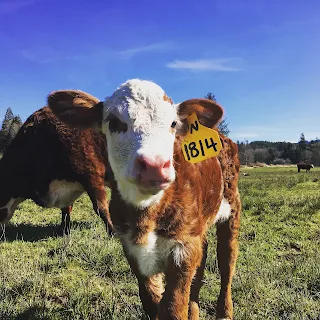Daffodils are stubborn optimists.
They thrust their heads toward the sky when it is still frustratingly winter. A glancing sliver of sunlight between gunmetal clouds is enough to fill them with dreams of spring.
Too often their butter-yellow heads are bowed and battered by hail or snow.
Still they promise something in the thin light of winter days. Often they are too early to seem anything more than a cruel joke.
When the grass is not yet green, and the trees are still naked skeletons stark against the wool-filtered light, the rain slants sideways and swirls in the wind. From high branches, bald eagles stalk smelt running in the dull waters of Grays River.
For the past 25 years I’ve owned in an old house across the field from my father-in-law, Hank Nelson. Each year I’ve had the opportunity to watch new life amid the green fields of the Grays River Valley. Here, the Nelsons have raised polled Hereford cattle for four decades.
It often feels still winter-gripped when the first calf is born at Nelson Polled Herefords.
The house is 100 years old now, but boasts big windows looking out over the fields. Often the cows will find a little shelter against the blackberry bushes to have their calf, but we keep a keen eye for the bright white of their new faces.
It is best to catch a new calf on their first day of life, for they stand quickly after they are born, so their mothers can clean them off and warm them up. Within a day, they will be quick enough that catching them will be tricky without a rope or shepherd’s hook. Each calf is tagged with a bright yellow tag and they are given a number: the year of their birth, and the order of their birth in that year. Thus 1801 is the first calf of 2018 and so on.
The ear tag is like a pierced ear, the daffodil yellow makes it easy to determine if a calf has already been tagged as we walk through the fields.
Their mothers nose close to you while you are tagging them and giving them a little pro-biotic, but our polled Herefords are naturally hornless and are renowned for their gentle nature. Moreover, many of these cows were 4H show heifers in years past. My daughters still know them and call them by name.
Nature’s trick
It seems the weather gets better as the calves in the field become more numerous.
In truth, a warm early spring day sends a signal to the mothers that the time is best to bring new life into the world.
University of Arkansas researchers found that more spring calves are born when barometric pressure is high. Increasing barometric pressure discourages rain and helps ensure dryer weather. Animals take their cue from these weather changes to give their offspring a better chance at life.
Nature’s trick is to be born after the worst storms of winter, but early enough to grow strong and healthy before the next winter comes. The earliest-born calves might come on a dark day, but they may also have much longer to grow and thrive.
It doesn’t take long before the fields are filled with an entertaining herd of spry little calves that run with a gentle rocking motion and seem to weigh nothing in the face of gravity. They run at the slightest excuse and sometimes with no excuse at all. They race each other, they chase each other, they explore the world, pink little nose to pink little nose. They climb dirt piles to get a better look or play king of the mountain. They meet each other hours after birth and make fast friends.
Calf races are the best to watch, and we often stare captivated as the story plays out in front of us. One calf will get another started, another will nudge a socially awkward friend to join in, soon all of them will be running around the field, fearless, and in no direction at all.
Nearby an old babysitter cow might keep watch as their mothers graze a little further away, finding nutrition in the sugar-rich spring grass.
Life is a struggle
Spring here is a fickle thing. A cloudless day may be followed by a bone-chilling dark wind and soaking rain. Cold darkness following a glorious early spring day can snuff the feeble light of your hope for outdoor hikes and garden planning. Resigned, you tell yourself, “It is still only March,” and this realization makes summer seem so much further away.
We all have to live through the darkness of winter, and it is still winter yet.
Even if a day here or there is sunny.
No matter the buds on the trees and the iridescent clover lighting up the fields, we know well enough that there are months of wet and mud and struggle stretching out ahead.
The promise of new life keeps us going.
It is why new life is so prominent a symbol of the Easter season. In high latitudes, where winter is cold and freezing and sunlight a meager ration, most animals try to tie their reproduction to the promise of plenty that comes with the spring. Baby chicks are in the feed stores, new goats and lambs begin to appear in the fields of neighboring farms. New nests appear in the trees. Predator and prey, farm animal and wild — all adjust their evolutionary clocks to chime in the same season.
They do this not in celebration, but in resignation that life is not all sunshine, green grass and cloudless skies.
Life is a struggle. It is not as easy as a loping little calf in the field makes it look.
Yet maybe we can learn a little from the joy they bring to their first days.
Even in the pouring rain.
-30-
You can follow the all the new calf faces at @nelson_polledherefords on Instagram or at HankNelsonHerefords.com











